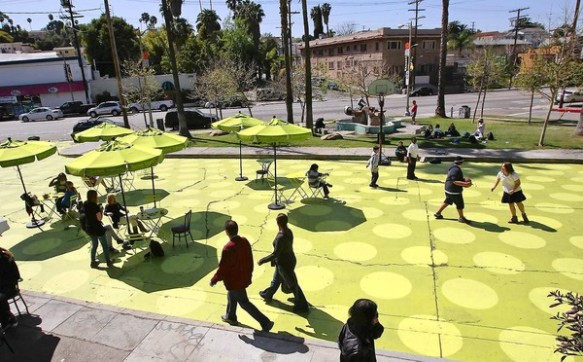This LA Times Story (July 27, 2014, front page) reports that Mayor Eric Garcetti hopes to transform 14 major thoroughfares into hubs of neighborhood activity. In a process the mayor describes as “urban acupuncture,” the city plans to add bike racks, plazas, crosswalk upgrades and other amenities aimed at drawing in pedestrians and attracting new businesses.
Why is this important? Today, more people desire to live walking distance to amenities, especially restaurants, bars, and shops. Previously, Angelenos demanded infinite amenities within an easy commute,not walkability. Now the trend is also for walkable amenities. This trend toward neighborhood workability has led to the recent increased popularity of Venice, Downtown Santa Monica, Downtown Los Angeles, and Silverlake. In Highland Park, once sleepy York Boulevard has become a magnet for an array of middle- and upper-middle class needs: coffee, comic books, vegan ice cream, and $5 donuts. Abbot Kinney Boulevard in Venice, once favored mainly by locals, is now a regional tourist destination with prices to rival Rodeo Drive. Walkable streets are now a major amenity attracting renters and home buyers.
So what comes first, retail amenities or residential. It is hard to say. Maybe it is a little of both. In Los Angeles, major employment centers must be within easy commute to a potential area in gentrification. Prices and rents very close to these employment centers are very high. So people seek more affordable areas. Someone takes a chance and opens a restaurant that takes off and attracts the gentrified demographic. A house renovator takes note and tries a renovation that succeeds. Other renovators take note and follow. Other retailers take note and follow. And so goes the chain reaction that plays out over years and even decades.
Now, Garcetti said he is trying to create conditions favorable to a transformation by targeting locations that already have sparks of new economic activity (retailers or housing renovation). He’s quick to point to success stories in the council district he represented before becoming mayor.
In Silver Lake, he closed one block adjacent to the Sunset Boulevard business district to car traffic, replacing it with a pedestrian plaza painted with green polka dots (Silverlake Triangle Plaza). In Atwater Village, Garcetti worked to make Glendale Boulevard — a major route to the 5 Freeway — more welcoming to pedestrians. City crews upgraded crosswalks, extending curbs farther into the street, and added new trees, signs and trash cans.
Now, on the Westside, Garcetti picked four blocks of Westwood Boulevard anchored by the Geffen Playhouse on one end and by UCLA’s Hammer Museum on the other. In Mar Vista, Garcetti picked Venice Boulevard between Beethoven and Inglewood Boulevard. On Figueroa Street in Highland Park, another corridor (between Avenue 50 and Avenue 60) selected by Garcetti, check-cashing businesses and pupuserias have been joined by workout places, a record shop, a vintage clothing store and Kitchen Mouse, a storefront restaurant that promises vegan and gluten-free dining options. Customer Elizabeth Brizzi said the area is starting to have the “Silver Lake feel” — a reference to the hip neighborhood once represented by Garcetti.
You can read the full article below.
Mayor sets out to transform L.A. streets through ‘urban acupuncture’ – LA Times.

